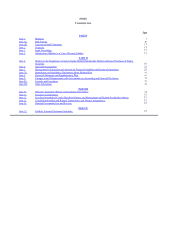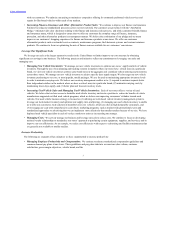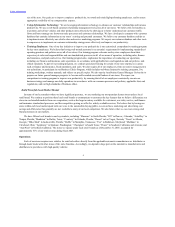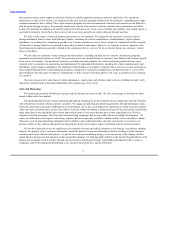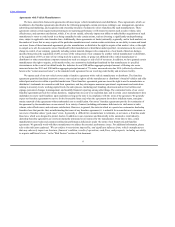AutoNation 2007 Annual Report Download - page 10
Download and view the complete annual report
Please find page 10 of the 2007 AutoNation annual report below. You can navigate through the pages in the report by either clicking on the pages listed below, or by using the keyword search tool below to find specific information within the annual report.
Table of Contents
condition, although such outcome is possible given the nature of our operations and the extensive environmental, public health, and safety
regulatory framework. We do not have any material known environmental commitments or contingencies.
We operate in a highly competitive industry. We believe that the principal competitive factors in the automotive retailing business are
location, service, price, and selection. Each of our markets includes a large number of well-capitalized competitors that have extensive
automobile store managerial experience and strong retail locations and facilities. According to the National Automotive Dealers Association,
Manheim Auctions, and reports of various industry analysts, the automotive retail industry is served by approximately 21,200
franchised automotive dealerships and approximately 43,000 independent used vehicle dealers. We face competition from several other
public companies that operate numerous automotive retail stores on a national or regional basis and from private market buyers and
sellers of used vehicles. We are subject to competition from dealers that sell the same brands of new vehicles that we sell and from dealers
that sell other brands of new vehicles that we do not represent in a particular market. Our new vehicle store competitors have franchise
agreements with the various vehicle manufacturers and, as such, generally have access to new vehicles on the same terms as us.
Additionally, we compete with other dealers for qualified employees, particularly for general managers and sales and service personnel.
In general, the vehicle manufacturers have designated specific marketing and sales areas within which only one dealer of a given
vehicle brand may operate. Under most of our framework agreements with the vehicle manufacturers, our ability to acquire multiple
dealers of a given brand within a particular market is limited. We are also restricted by various state franchise laws from relocating our
stores or establishing new stores of a particular brand within any area that is served by another dealer of the same brand, and we
generally need the manufacturer to approve the relocation or grant a new franchise in order to relocate or establish a store. However, to the
extent that a market has multiple dealers of a particular brand, as most of our key markets do with respect to most vehicle brands we sell,
we are subject to significant intra-brand competition.
We also are subject to competition from independent automobile service shops and service center chains. We believe that the principal
competitive factors in the service and repair industry are price, location, the use of factory-approved replacement parts, expertise with the
particular vehicle lines, and customer service. In addition to competition for vehicle sales and service, we face competition from a broad
range of financial institutions in our finance and insurance and aftermarket products businesses. We believe the principal competitive
factors in these businesses are product selection, convenience, price, contract terms, and the ability to finance vehicle protection and
aftermarket products.
Our business exposes us to the risk of liabilities arising out of our operations. For example, liabilities may arise out of claims of
employees, customers, or other third parties for personal injury or property damage occurring in the course of our operations. We could
also be subject to fines and civil and criminal penalties in connection with alleged violations of federal and state laws or regulatory
requirements.
The automotive retailing business is also subject to substantial risk of property loss due to the significant concentration of property
values at store locations. In our case in particular, our operations are concentrated in states and regions in which natural disasters and
severe weather events (such as hurricanes, earthquakes, fires, landslides, and hail storms) may subject us to substantial risk of property
loss and operational disruption. Under self-insurance programs, we retain various levels of aggregate loss limits, per claim deductibles,
and claims-handling expenses as part of our various insurance programs, including property and casualty, workers’ compensation, and
employee medical benefits. Costs in excess of this retained risk per claim may be insured under various contracts with third-party
insurance carriers. We estimate the ultimate costs of these retained insurance risks based on actuarial evaluation and historical claims
experience, adjusted for current trends and changes in claims-handling procedures. The level of risk we retain may change in the future as
insurance
8


